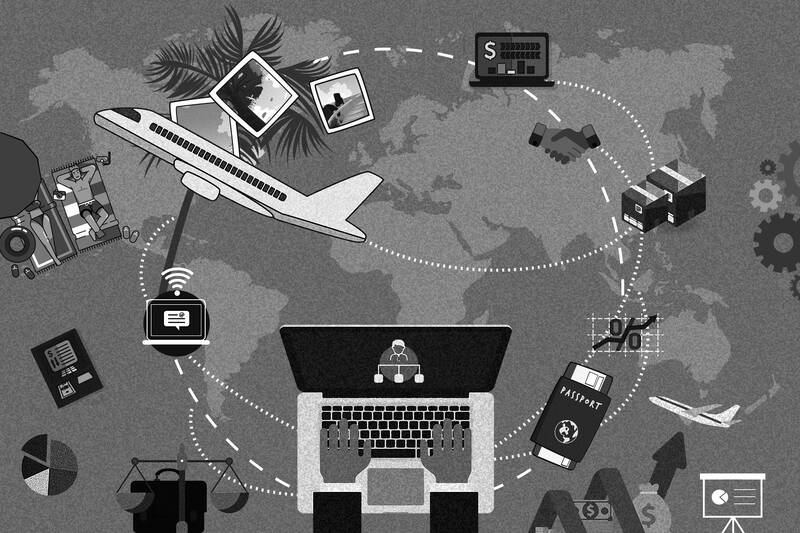During the height of the COVID-19 pandemic, airline executives knew travel would recover eventually when vaccines were widely available. They also had a vague notion that flying patterns would change. They were right on both counts.
Demand is closing in on 2019 levels, and executives are getting a clearer picture of how the pandemic modified passenger behavior. Those changes and pent-up appetite for travel will continue to benefit airlines despite continued COVID-19 risks and capacity constraints that will keep airfares elevated for some time.
One of the biggest drivers of the new flying patterns is the ability to work remotely. Business and leisure travel are being combined in a new trend that airlines call hybrid work.

Illustration: Louise Ting
People are extending their business trips to add a few days of sightseeing. They also have the flexibility to travel more often and to vary their schedules; they can fly during the week and work a couple of days from an Airbnb while the family hits the beach or the slopes.
As a result, United Airlines Holding, which reported third-quarter results on Tuesday, had the third-highest revenue per available seat kilometer in its history last month, despite September usually being an off-peak month.
Delta Air Lines Inc is experiencing more demand during the week and seeing less of the typical spikes of departures on Sunday and Monday with return trips on Friday.
“What we’ve seen is demand has come back very different in 2022 than it left in 2019,” Delta president Glen Hauenstein told analysts in a conference call last week.
Domestic flying in the US was the first segment to rebound, and it continues to be strong.
Travel to Europe is now leading the recovery of international travel, and Asia is picking up as countries such as Japan begin to reopen.
United said on Tuesday that it had restarted flights from the US to Tokyo and to Edinburgh, Scotland, for example, and added a new route to Cape Town. China is still a big holdout with its “zero COVID-19” policy, and it is impossible to forecast when that will change.
However, the trend is clear: People are returning to the skies.
During the height of the pandemic, when airports were ghost towns, some were predicting that travel would never return to normal and workers would just settle for Zoom meetings. In 2020, it was hard to conceive that people would crowd together again to travel by air. In contrast, business travelers and tourists are now willing to climb into a small metal tube packed with a few hundred maskless strangers.
However, COVID-19 has by no means vanished. There are still about 37,000 new cases a day in the US and 321 daily deaths over a seven-day moving average, US Centers for Disease Control and Prevention data show.
That is down considerably from a peak of 812,000 daily cases in January and daily deaths as high as 2,700 in February.
People are more confident that if they are healthy and vaccinated, COVID-19 is more like the flu than a death sentence.
For those passengers willing to take the risk, they will continue to pay up for the privilege to fly. In the second quarter of this year, ticket prices in the US jumped 22 percent year-one-year, US Bureau of Transportation Statistics data showed.
This is a function of the inability of aircraft manufacturers to keep up with demand, a dearth of pilots and even constraints at air traffic control centers and some busy airports.
Airlines cannot add all the capacity they want, and that means prices will rise.
United said its capacity this quarter would be about 10 percent below the same period in 2019.
Delta’s capacity is still 17 percentage points behind the 2019 level, and it expects its network to be fully restored by next summer.
This is not a short-term problem. It could take four or five years to work through the issues crimping capacity, United CEO Scott Kirby said on Wednesday.
This is why revenue and profits will rise for airlines even as the economy slows and inflation eats away at consumer buying power.
“Supply is going to be constrained for years to come by artificial factors,” Kirby said. “Boeing and Airbus are way behind, and the supply chains are way behind on their ability to produce new airplanes.”
This is great for airline profits, but not so much for passengers.
United’s planes were 87.3 percent full in the third quarter, up from 76.1 percent last year and topping the same period in 2019, which was 86.1 percent.
Having full planes translates into higher earnings, and United forecast that adjusted operating margins this quarter would beat those of the fourth quarter of 2019.
However, not all airlines are happy with the shortage of planes.
Michael O’Leary, chief executive officer of low-cost carrier Ryanair Holdings, said that the “only dark cloud on our horizon” is Boeing’s inability to deliver the 21 737 Max aircraft that the Irish airline is supposed to receive before Christmas.
O’Leary expects to get maybe a dozen of those new planes. With more capacity, Ryanair would be able to take market share in an environment of rising ticket prices.
Airlines expect to have fully recovered by next year, when corporate travel, the last holdout, would return to normal.
COVID-19 cases and even deaths will likely never go to zero, but the risk is on the decline, and people are learning to live with it.
After all, thousands die each year from flu strains that have been around for a century or more. Packed airplanes, restaurants, concerts and sports stadiums point to people resuming their lives.
The big question is whether the combination of business and leisure trips is a long-term trend and whether remote work will last, providing people with those flexible travel schedules that airlines are loving. For now, airlines are betting this new work-life balance is here to stay.
Thomas Black is a Bloomberg Opinion columnist covering logistics and manufacturing. Previously, he covered US industrial and transportation companies, and the Mexican economy and government.
This column does not necessarily reflect the opinion of the editorial board or Bloomberg LP and its owners.
Congratulations to China’s working class — they have officially entered the “Livestock Feed 2.0” era. While others are still researching how to achieve healthy and balanced diets, China has already evolved to the point where it does not matter whether you are actually eating food, as long as you can swallow it. There is no need for cooking, chewing or making decisions — just tear open a package, add some hot water and in a short three minutes you have something that can keep you alive for at least another six hours. This is not science fiction — it is reality.

A foreign colleague of mine asked me recently, “What is a safe distance from potential People’s Liberation Army (PLA) Rocket Force’s (PLARF) Taiwan targets?” This article will answer this question and help people living in Taiwan have a deeper understanding of the threat. Why is it important to understand PLA/PLARF targeting strategy? According to RAND analysis, the PLA’s “systems destruction warfare” focuses on crippling an adversary’s operational system by targeting its networks, especially leadership, command and control (C2) nodes, sensors, and information hubs. Admiral Samuel Paparo, commander of US Indo-Pacific Command, noted in his 15 May 2025 Sedona Forum keynote speech that, as
In a world increasingly defined by unpredictability, two actors stand out as islands of stability: Europe and Taiwan. One, a sprawling union of democracies, but under immense pressure, grappling with a geopolitical reality it was not originally designed for. The other, a vibrant, resilient democracy thriving as a technological global leader, but living under a growing existential threat. In response to rising uncertainties, they are both seeking resilience and learning to better position themselves. It is now time they recognize each other not just as partners of convenience, but as strategic and indispensable lifelines. The US, long seen as the anchor
Kinmen County’s political geography is provocative in and of itself. A pair of islets running up abreast the Chinese mainland, just 20 minutes by ferry from the Chinese city of Xiamen, Kinmen remains under the Taiwanese government’s control, after China’s failed invasion attempt in 1949. The provocative nature of Kinmen’s existence, along with the Matsu Islands off the coast of China’s Fuzhou City, has led to no shortage of outrageous takes and analyses in foreign media either fearmongering of a Chinese invasion or using these accidents of history to somehow understand Taiwan. Every few months a foreign reporter goes to